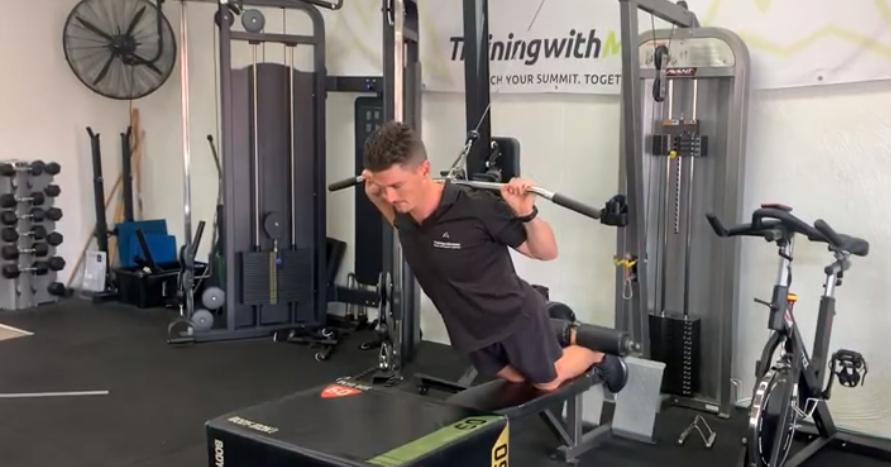Quick Summary:
- Nordic Hamstrings are hard but they are a fantastic way to strengthen your hamstrings and enhance your sports performance.
- You need to ensure that you progressively overload these safely so that you do not over-reach, cause injury or pull up extremely sore.
- The Nordic builds hamstring, glute, lower back strength and trunk stability.
The hamstring muscles consist of four muscles located in the back of your thigh—the semi-membranosus and semitendinosus on the inside part of your leg, and the biceps femoris long and short head on the outside part of your leg.
The Nordic Hamstring can destroy one’s ego in a second. Those that think they have strong hamstrings may face a harsh reality check. It’s a critical exercise that helps bulletproof your hamstrings particularly for sports performance.
This is why we quite often we see a lot of athletes and clients avoid doing this exercise. A lot of people try to turn a blind eye as they don’t want to take a few steps backward in order to go forward and would therefore rather continue with their weaker hamstrings and poor symmetry than regress the exercise to suit their ability.
It’s not an overly difficult exercise from a technical point of view however it is still a tough exercise to master – even for individuals who can squat and deadlift large amounts!
Quite often we see individuals have fantastic bilateral strength (two lower limbs performed together) however when we measure the force production of a nordic hamstring we may identify large discrepancies between hamstrings which increases the chances of an injury occurring.
Majority of the sports we play require a high level of explosive pace, ballistic movements and rapid changes of direction (sprinting, kicking, jumping etc) – these require the posterior chain to be efficient. This is exactly what the Nordic Hamstrings can help to do.
Most hamstrings “pulls” or strains occur when the athlete is reaching their foot out in front of them while sprinting, because that’s when the hamstring is both being stretched and having to decelerate the leg as the foot strikes the ground.
That is why we encourage our clients and athletes to swallow their pride, begin basic and overload progressively.
So why is this exercise so difficult:
You are essentially loading your hamstrings at half of your body weight+ eccentrically. The delayed onset of muscle soreness which is often associated with Nordics has been attributed to the increased tension force and muscle lengthening from the eccentric component of the exercise. Eccentric lengthening cause the actin and myosin cross-bridges in the muscle to separate prior to the amortisation phase – ultimately causing greater tension on the active motor units.
If one of the muscles that make up the hamstrings doesn’t fire correctly or you have weak hamstrings, you won’t be able to perform the exercise correctly and therefore you’re likely to make one of the following mistakes:
- Rotating your upper back: Your back should be as square as possible.
- Rotation of your hips: Just like your back, your hips should stay square, too.
- Lumbar Flexion initially: Your first movement should be to move at the knee joint and not at the lumbar spine. This is a common mistake.
- Losing balance or moving too quickly during the repetition. Losing balance is common. It’s usually an indication that you need to regress, the exercise because the exercise is challenging your capabilities outside of your body’s ability to maintain proper posture. This is when you know you need to take a bite of humble pie.
Here are the general cues for the complete Nordic hamstring:
1. Ensure partner or grip through the foot holders is extremely firm.
2. Take a breath in and embrace your core.
3. Begin to move at the knee joint and ensure you are not entering lumbar flexion.
4. Place tension through your hamstring and control eccentrically at a level that is appropriate.
5. Depending on the type of Nordic you are doing when you reach the ground perform a push up, avoiding the concentric component and return to the starting position.
Here is our 6 x step progressions:
1. Nordic Hamstring with Swisse Ball
Start here. Put pressure on the Swisse Ball when performing the movement to relieve the tension on the hamstrings. This way initially will reduce your Range Of Motion (ROM) and lead to better control.
2A. Nordic Hamstring With A Lat Pull Down Resistance
Use the Lat Pull Down (LPD) Bar to reduce tension eccentrically to the level that you would like and it will assist on the concentric component back to the starting point. This movement allows you to progress to greater ROM. Progress difficulty by reducing the weight on the LPD.
2B. Nordic Hamstring With A Resistance Band.
This is essentially the same as #2 but can use without a machine at home.
3A. Nordic Hamstring without partner
This movement should be performed when you are on your own. Utilise a LPD/GHB or any other machine that you can lock your feet into, to resemble the act of a partner holding your feet. You can also wedge your feet underneath something, place a barbell on the ground/ between a squat rack that creates a locking mechanism at the ankles.
3B Nordic Hamstring with a partner.
This is the ideal method of performing the movement. Control the eccentric movement as slowly as possible.
4. Nordic Distal Hamstring Progression
This is an advanced method of training and should only be completed once you have progressed the strength of your hamstrings. This targets the distal hamstring (closer end to the knee) and involves lumbar flexion unlike the other movements (see video). Use your hands in a crawling manner to increase/decrease your tension.
GOOD LUCK,
DAN MAITLAND

